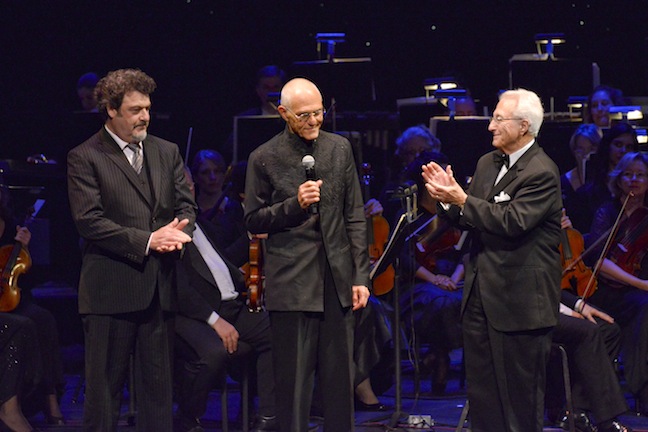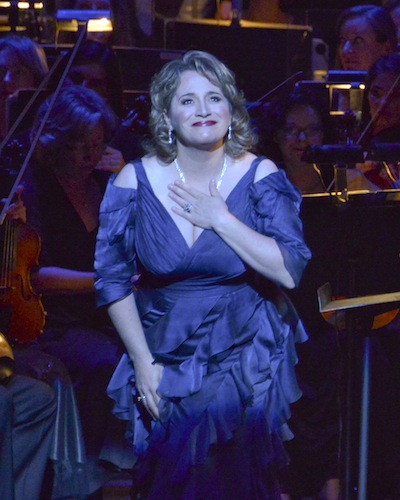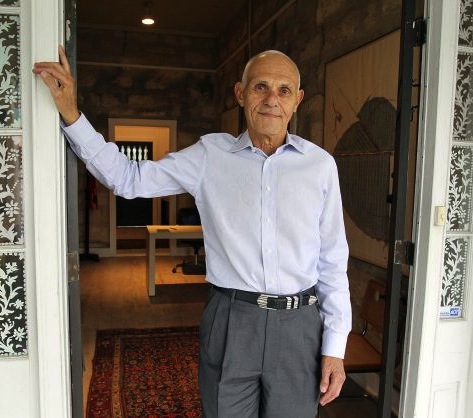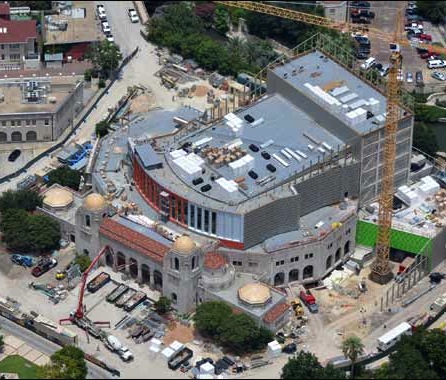


TOSA leaders Tobias Picker, Mel Weingart and Plato Karayanis at the opera
company's inaugural concert, last May in the Majestic Theatre. Photo by Karen Almond.
The Opera San Antonio
'Stepping stones to building a brand'
There was a time, long ago but within the memory of many people still alive today, when San Antonio was a nationally important center for opera.
The San Antonio Symphony’s annual Grand Opera Festival, established in 1945, brought many of the world’s most important singers to town, along with opera connoisseurs from throughout Texas and beyond. After the symphony ceased opera production in 1983, other organizations arose to carry the torch, but the flame sputtered, occasionally burning brightly, sometimes going out entirely, but mostly producing a mediocre light.
The picture at the moment is confused, with two torchbearers vying for attention. One is Opera Piccola, the new venture of Mark Richter, who built San Antonio Opera from modest beginnings and resigned as general director in late 2011, a few months before the company went belly-up with nearly $900,000 in debts. Opera Piccola began with small-scale shows in the Josephine Theatre and this weekend moves up to the Empire Theatre with a production of Gian Carlo Menotti’s “The Medium.”
Although one should not dismiss Richter’s chances out of hand -- he is nothing if not tenacious -- the history of his previous company does not exactly instill confidence in the future of his new one.
Meanwhile, another opera company has emerged, this one with major-league ambitions, internationally prominent leadership and significant financial backing -- a degree of credibility that eclipses every previous local effort of the past several decades.
The Opera San Antonio begins life with a celebrated composer, Tobias Picker, as its artistic director and a legendary administrator, Plato Karayanis (general director of Dallas Opera from 1977 to 2000), as its interim general director. The board chairman and cofounder, Mel Weingart, connects the company with a home-grown, nationally important figure in opera patronage: Weingart is also chairman and president of the Tobin Theatre Arts Fund, part of the philanthropic legacy of the late Robert L.B. Tobin, who was a major supporter and board member of both Santa Fe Opera and the Metropolitan Opera.
TOSA made its first public splash
 in the
Majestic Theatre last May, after a gestation of several
years, by bringing in a raft of luminous singers --
soprano Patricia Racette, mezzo Dolora Zajick, tenor Jay
Hunter Morris and bass-baritone Eric Owens, among others
-- for a concert of arias and ensembles with the San
Antonio Symphony under its music director, Sebastian
Lang-Lessing. The star power was fully comparable to the
glory days of the symphony’s Grand Opera Festivals, and
linking to that history was fully intended by TOSA’s
leaders.
in the
Majestic Theatre last May, after a gestation of several
years, by bringing in a raft of luminous singers --
soprano Patricia Racette, mezzo Dolora Zajick, tenor Jay
Hunter Morris and bass-baritone Eric Owens, among others
-- for a concert of arias and ensembles with the San
Antonio Symphony under its music director, Sebastian
Lang-Lessing. The star power was fully comparable to the
glory days of the symphony’s Grand Opera Festivals, and
linking to that history was fully intended by TOSA’s
leaders. TOSA’s origin was entwined with the planning for the Tobin Center for the Performing Arts. In 2008 Bexar County voters approved a proposition to use $100 million in occupancy-tax funds to build a new multi-venue facility within the footprint of the Municipal Auditorium. The large theater in the plan would be designed to accommodate orchestral concerts, dance and opera -- presumably, at the time, San Antonio Opera.
But that company's artistic track record was uneven and its fundraising capacity inadequate. Mr. Weingart and others -- most notably Bruce Johnson, a Chicago transplant who had served for a time as San Antonio Opera’s board chairman -- set out to create a new company on firmer footing.
In 2009, Mr. Weingart recruited Mr. Picker to join the team. The two had known each other since the premiere of “An American Tragedy” at the Met.
“We formed an exploratory group made up of 15 individuals from important components of the community,” Mr. Weingart recalled. “That exploratory group had three meetings over a four-month period, and the overwhelming consensus was that we had to move forward with the plans we had at that point. Then a feasibility study was funded by a grant from the the Kronkosky Charitable Foundation with a match.”
Bud Franks, the consultant who had conducted the feasibility study for the Tobin Center itself, also did the study for the new opera company.
In the spring of 2011, Mr. Weingart set a financial goal: “We had to raise $500,000 within six months in order to have operating funds.”
The company set up offices in a restored mid-19th-century house adjacent to the Tobin Theatre Arts Fund's headquarters just north of downtown. Both buildings are part of a collection of Irish Flats structures that were restored by Margaret Tobin, Robert's mother.
Quiet, methodical planning eventually paid dividends.
“The very expensive gala [last May] was totally funded, and we were left with money in the bank,” Mr. Weingart said.
Soprano Patricia Racette takes bow at The Opera San Antonio's inaugural concert, last May in the Majestic Theatre. Photo by Karen Almond.
 San
Antonio Symphony on a semi-staged and costumed version of
Antonin Dvorak’s opera “Rusalka” this January.
San
Antonio Symphony on a semi-staged and costumed version of
Antonin Dvorak’s opera “Rusalka” this January. “From a financial standpoint we are extremely healthy,” Mr.Weingart said.
The nascent company is still moving on a path of “measured progress,” in the words of Mr. Karayanis. The next project after “Rusalka” is likely to be a contemporary chamber opera in a non-traditional venue, next spring. The first fully-staged large-scale production -- probably a standard work -- is expected in January 2015 in the Tobin Center.
“We’re building stepping stones,” Mr. Karayanis said.
“This collaboration [Rusalka] with the symphony is a lot less expensive than a full production, but it gets our name out. Then [we will be] doing a chamber opera that we hope will have a lot of media attention. By that time we will have announced what we’re doing in the Tobin Center. These are all stepping stones to building a brand.”
The selection of Mr. Picker as artistic director could make that brand distinctive.
Mr. Picker took the job “for the challenge,” he said by phone from San Francisco, where he was overseeing rehearsals for the world premiere of his Dolores Claiborne with San Francisco Opera.
“I want to see whether, as a composer, I can bring to a company what others can’t do. I want to see whether it makes a difference and helps to turn around the trend (of declining opera attendance). I hope to inject life into something that is supposed to be a living art form, but that is dying,” Picker said.
“The audience is collapsing, dropping throughout the country. There are very few companies where it’s not dropping off. Companies are trying to figure out a way to get people to come back. I don’t think repeating Carmen, Boheme and Butterfly will bring them back.”
Picker, Weingart and Karayanis agree that the company’s repertoire will include both standard and contemporary operas, and the début work in the Tobin Center is likely to be something familiar. (The leadership team is not ready to disclose which opera that will be.)
“Older familiar works -- yes, we have to do some of that, but we have to do fresh new productions, not stale, old, mediocre productions, so old works come off as though they were new,” Picker said. “But (I would) emphasize new and recent operas and market them in a way that will bring in a new audience.”
He believes that, being a composer himself, he is well placed to commission new works for the company.
“I know what my colleagues are up to. I don’t want to give an example of people I’m considering commissioning, but they’ll be much more interesting than what the average opera company is doing.”
Mel Weingart, TOSA board chairman, stands in the doorway of the company's offices, in a restored Irish Flats house near downtown San Antonio.
The Tobin Center under construction. Photo by Red Wing.
 Although the new
company will have access to the small black-box theater at
the Tobin Center, Picker said he also will be looking for
alternative venues, comparable to those used by Vertical
Player Repertory in New York, for chamber operas.
Although the new
company will have access to the small black-box theater at
the Tobin Center, Picker said he also will be looking for
alternative venues, comparable to those used by Vertical
Player Repertory in New York, for chamber operas. Picker acknowledges that “it’s going to require a very brilliant marketing campaign” to draw a sufficient audience. “What remains to be seen is whether the community, and the people who can afford it, want it.”
Emblematic of the company’s conservative approach to financial planning, Weingart said he expects earned income to account for only 20-25 percent of the budget in its first season. The Tobin Center’s seating capacity (and thus its earned-income potential) will be on the small side for opera. Though the new hall will seat 1,750 for symphony concerts, opening the orchestra pit will cut that number to 1,660 seats, on the small side for opera. Furthermore, the limited wing space (compared to single-purpose opera houses) will make it difficult to produce two operas in repertoire, a scheduling practice that can encourage attendance from out of town and thus possibly increase the number of performances.
TOSA’s leaders are determined to move carefully and not to overextend the company. Growth in the number of productions is likely to be slow.
“There’s nothing we would like more than having people be angry with us for not doing enough,” Weingart said.
Karayanis concurred: “We’re not in a quantity business, we’re in a quality business.”
Mike Greenberg